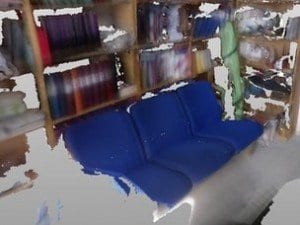Humans are being asked to help robots recognise the multitude of objects found in the average home.
Swedish researchers are asking people to use their Xbox’s Kinect sensor as a scanner to grab detailed 3D images of the stuff in their homes.
The Kinect@home project requires mass participation to accumulate many examples of common household objects.
The scans will build into a library of objects robots can consult as they navigate around homes.
Slow scan
Co-ordinator Alper Aydemir said: “Factory floors can be custom built and the tools the robots will use can be known precisely in minute detail. This is not the case with everyday living spaces and objects.”
While humans have no trouble recognising objects such as a tea mug even if it is a different colour, shape and size to those they have seen before, robots struggle to complete such a mundane task.
“One of the best ways for robots to accomplish all these tasks is to make them learn how to recognise a sofa, a chair, or a refrigerator by feeding them lots of data,” Mr Aydemir told the BBC.
Rather than building up the database of objects by themselves, the team from the Center for Autonomous Systems at Sweden’s Royal Institute of Technology have turned for help to the many people who have bought a Kinect game sensor for their Xbox console.
The Kinect sensor uses a combination of an infra-red sensor, camera and customised computer chip to spot and interpret the movements of gamers, letting them play without a traditional hand-held controller.
The device has to be calibrated to each user before use and becomes less accurate if they are wearing glasses.
But its developers say they think it has the potential to offer a more natural way to control TVs and other devices, and are hoping to partner with more manufacturers.
“The free Tobii Gaze Interaction software development kit is available to companies interested in exploring the possibilities of gaze interaction and using this revolutionary technology to develop gaze applications that will take part in the future of computing and consumer electronics,” said Tobii’s chief executive Henrik Eskilsson.
Eye-controlled cars
Tobii originally developed its products to help disabled people control computers.
Its sensors and software currently cost thousands of pounds to purchase, which have prevented their widespread adoption.
But over recent months the firm has been showing off concept designs for gaze-controlled car information systems, surgery room image display screens, and video games.
PC-maker Lenovo has also created a concept laptop with the technology built-in which scrolls through text documents, keeping pace with the user as they look through a document.
via BBC
The Latest Streaming News: Robots in the home updated minute-by-minute
Bookmark this page and come back often
Latest NEWS
Latest VIDEO









